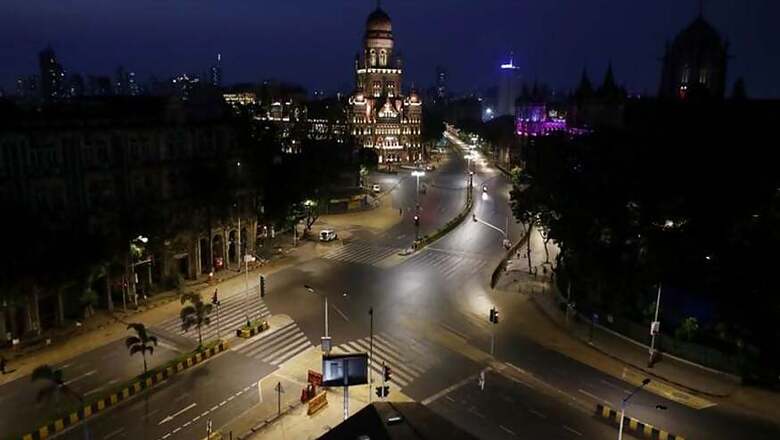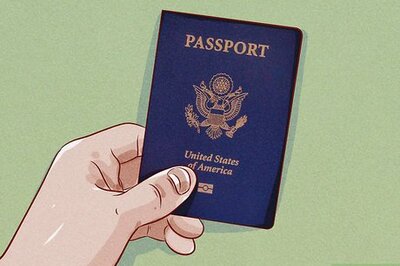
views
Mumbai: Maharashtra has emerged as the state with the highest number of Covid-19 cases nationally now. A total of 490 positive cases, 85% of them asymptomatic, 26 deaths, cases emerging from Mumbai slums, and many of the approximately 1,400 persons who had attended the Delhi congregation of the Tablighi Jamaat from Maharashtra yet to be tested – the challenges in front of the state have only begun. The city of Mumbai, which shares the maximum number of cases in Maharashtra – 278 of the 423 – has already seen massive curbs in movement in the 212 containment zones where novel coronavirus patients have been found.
Even as authorities hope that the nationwide lockdown period will give them precious time to procure medical equipment and medicines, each day continues to pose new predicaments. Also, some health experts lament that the government did not pay heed to the suggestion of halting international flights a month ago. “We had recommended that all international flights be stopped immediately, and that people getting down at the airports be compulsorily quarantined. Had the government taken the suggestion seriously then, we could have controlled the spread,” a senior public health official told CNN-News18.
Authorities are scrambling to trace the people who attended the Tablighi Jamaat congregation last month. “The state administration has managed to trace the citizens of Maharashtra who had participated in the Markaz in Delhi. They have been quarantined,” chief minister Uddhav Thackeray said on Thursday. Prime Minister Narendra Modi had appealed to him to press the state machinery into service to aggressively trace the people who had participated in the Delhi event. Maharashtra health minister Rajesh Tope told reporters that 1,300 of the 1,400 attendees had been traced. But a press note issued by the state government stated that 890 of the 1,062 participants had been contacted, and 576 of them had been put in isolation wards. Of that group, four have tested positive. Two of them are from Pimpri-Chinchwad and two from Ahmednagar.
While lakhs of migrant labourers are waiting at the sealed borders of various districts, agricultural activities too have been hampered due to the fear of the pandemic. The state exchequer, which was already in the red, is further burdened by this unexpected outbreak. While the Maharashtra government has announced it will give salaries to employees in two instalments in order to ease some burden, it has also sought a special package of Rs 25,000 crore from the Centre. “The Centre should also pay us the dues of Rs 16,000 crore as soon as possible,” deputy chief minister Ajit Pawar said. In a bid to help the farmers, the administration has also announced the procurement to 10 lakh litres of milk daily at the rate of Rs 25/litre, to contain the disruptions in the milk collection and distribution network.
At present, challenges in front of the authorities are many. Officials say that a metropolitan place like Mumbai has failed woefully in adhering to a complete lockdown. Also, across the state, many people have tried to hide their travel history, creating roadblocks for the public health service providers. “The impact of a lockdown on the spread of the virus can be seen only if it is followed to around 90 per cent. But in Mumbai, the figures are lower. It is disappointing. It is also a cause of worry. In other places, the response has been much better. People have stayed back in their houses,” said Dr Satish Pawar, director, Maharashtra Health Services.
In fact, it is a matter of such frustration for the authorities, that deputy CM Ajit Pawar has warned of stringent action against such people. “Don’t make us take harsh steps. It is better you quarantine yourselves happily in your homes, instead of we having to quarantine you in the institutional facilities,” he said to the people of the state. Misbehaviour with government officials, doctors, law enforcement agencies, is another challenge.
“Presently, in a place like Mumbai, there are two fears. Firstly, there is a suspicion of community transmission. Secondly, there are a large number of asymptomatic positive patients. This is a huge cause of concern, as it means transmission in the community is likely,” Dr Satish Pawar said.
The beginning
“It all started with five-six clusters in the state. In fact, it was the cluster that went to Dubai, that took the Maharashtra figures to a high level,” said Dr Pradip Awate, state epidemiologist. “As these clusters started emerging, Maharashtra immediately took the decision to aggressively do contact tracing. We traced the highest contacts, and though they were asymptomatic, we got them admitted and tested. Of the first cluster of 40 persons who took the Dubai tour, 37 were from Maharashtra, and three were from Belgaum. Then there was a Mumbai cluster, a Navi Mumbai cluster of the 10 Filipinos (who had attended the Delhi congregation). The fourth cluster was the Kalyan one where the man had returned from the US. In all these clusters, majority of the people had travel history. For those who didn’t have it, we aggressively did contact tracing,” he said.
Dr Awate denied that Maharashtra was at community transmission stage. But there have been sporadic cases where the transmission link has not yet been established, and the patients have had no travel history or contact history. “As per my assessment, we are still in stage 2. You don’t know who has given the infection to whom,” he said.
Cluster containment strategy
With a spike in the number of cases, Maharashtra has started implementing the cluster containment strategy, as directed by the central government. “2332 teams are working across the State for cluster containment. In Mumbai, there are 292 teams. In Pune municipal corporation area, there are 373 teams. Nagpur has 210 teams involved in door-to-door surveillance,” health minister Rajesh Tope said. In Mumbai alone, 212 containment zones were created till Thursday night. It means completely stopping any movement of local residents from a place where a Covid-19 positive patient has been found.
“When we create a containment zone, which typically is 1.5 kilometres radius of the location where the patient is found, or the boundary wall of that housing complex, we do surveillance of that population. We form teams to survey the entire population for two weeks. We do health mapping. We take information from the local doctors about the kind of health complaints received by her/him. IEC (Information, Education, Communication) activities are enhanced there. This is more of a door-to-door surveillance. Beyond that, till 3 to 5 kilometres is the buffer zone where we conduct passive surveillance,” Dr Awate said.
Figures so far
So far, Maharashtra has tested 10,873 persons. Of them, 10,280 have tested negative. 423 have tested positive. 42 patients have been cured. 38,244 are home quarantined, while 2,138 people are institutionally quarantined. “Isolation wards have been started in all district hospitals and government medical colleges across the state,” Tope said.
Till now, 490 positive cases have been found in Maharashtra. 26 of them are dead. And while a majority of the cases are from Mumbai (278), other places far and wide too have thrown up Covid-19 positive cases. Pune has 70 cases, Sangli 25, municipal corporations in Thane have 45, Nagpur has 16, Ahmednagar 20, Yavatmal four, Buldhana five, Satara three, Aurangabad three, Kolhapur two, Ratnagiri two, and one each in Sindhudurg, Gondia, Jalgaon, Nashik and Osmanabad.
Only lockdown won’t help
Medical experts have said that though lockdown is an important step, it is just one step in a multi-pronged approach that needs to be aggressively followed by the state right now. “Firstly, the testing should increase substantially. Secondly, we need to aggressively find out suspected cases, their contact tracing. Also, we need to start isolating and quarantining them. Their observation and treatment should start right there. Even in case of doubts, people should be home quarantined. We have already ordered a million kits. There is an urgent need for health quarantine, self isolation. As a common person, if I see symptoms, I should isolate myself. I should telephonically consult the family doctor. The entire system needs to encourage this,” said Dr Subhash Salunke, former director general of the state health department and current technical consultant to the Maharashtra government.
He also emphasised on the need for awareness among people. “Social stigma is another challenge. People fear, they will be stigmatised. Hence, they don’t disclose their travel history. There is also an element of irresponsibility. Entire Islampur had to be locked down as the suspects refused to be home quarantined, and continued to roam freely. This kind of reckless behaviour will make us pay a heavy price. If we fail, the projections for the State are very scary,” he said.
Large vulnerable population
“Our population is already vulnerable. It isn’t just about the persons who are 60-plus. We have a sizeable population of under-five and under-10 malnourished children. With co-morbidity, even the old are vulnerable,” Dr Salunke said.
Brinelle D’Souza, an academic, pointed out that the public health infrastructure of Maharashtra was already weak due to consistent neglect. Our public healthcare system is already fragile and crumbling. If this gets into community transmission, we will not be able to manage it. There are very few medical equipment and safety gears available with the government. Also, because we have a large number of vulnerable population, the patient care for other ailments will get affected if all the attention is focused only on Covid-19.”
Migrant labourers
A large number of migrant labourers are currently stuck on the sealed borders of several districts. “The state government has set up 3,000 camps across the State, and is providing meals and shelter to 3.25 lakh people from other states, and has also appointed experts and doctors to ensure good mental health. Earlier, the number of tests conducted was low, and hence the number of patients was also less. Since the private diagnostic centres have been allowed to conduct tests, the results are coming out quickly and that is why the number of patients seems to be going up very fast. However, these patients have been admitted to the hospitals, and their condition is stable.
Earlier, the hospitals run by the BMC had just 28 isolation beds, but now their number has been increased to 2,100. 7 hills hospital has been converted into a 1,500-bed facility for Covid-19,” Maharashtra CM Uddhav Thackeray said.



















Comments
0 comment